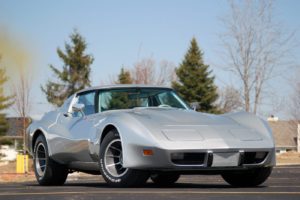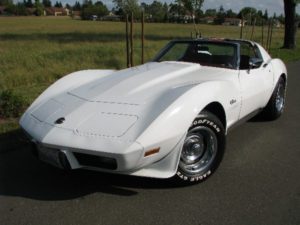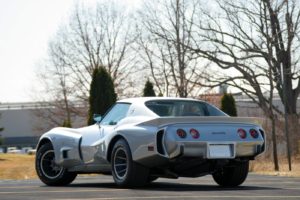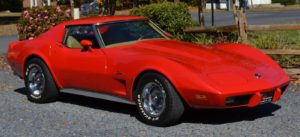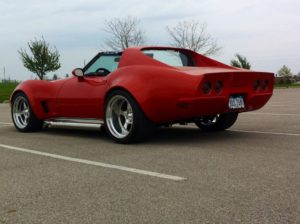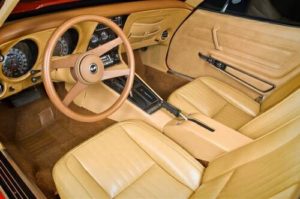By 1976, the United States economy was on the mend from the 1973–1975 global economic recession. The recession, which had been caused in part by the 1973 oil crisis, had caused gas prices to soar which, in turn, had made automotive manufacturers begin re-evaluating the types of vehicles they were manufacturing.
It had led to the end of the big-block engine era for Chevrolet, and had further influenced the decision being made by automotive manufacturers everywhere to increase fuel economy at all costs – even if it meant a loss in horsepower as a result. However bad the prognosis had looked just a year earlier, 1976 had seen President Jimmy Carter come into office and with him, an eventual economic stimulus package that would re-strengthen a diminished economy.
Despite the economic hardships felt around the world, the 1976 Stingray had arrived on the heels of one of Corvette’s most successful sales years ever. The commercial success of the 1975 Corvette coupe (but not the convertible) had strengthened Chevrolet’s resolve to do away with the roadster option and focus solely on producing the best edition of their popular sports car possible. It was a gamble that would prove to pay off.
Pricing: $7,604.85 (Coupe)
Engine: 350ci, 180HP Engine (standard) 350ci, 210HP Engine
Transmission: 4-speed manual (standard), 4-speed manual (close ratio), 3-speed Turbo Hydra-Matic automatic (optional)
Top speed:
Units Produced: 46,558
Available Colors: Classic White, Silver, Bright Blue, Dark Green, Mahogany, Bright Yellow, Buckskin, Dark Brown, Orange Flame, Red
Highlights of the year:
Stylistically, the 1976 Corvette was the best looking of the C3 Corvettes to date. While the changes to the exterior were minor, they were significant from an aesthetics standpoint.
To start, the air-extractor vents were removed from the rear deck. These vents, which had been part of the C3 Corvette since 1968 (they served as the exhaust mechanism for Corvette’s Astro-Ventilation system,) were eliminated along with the ventilation system itself.
Similarly, the 1976 Corvette’s hood no longer featured a cowl flap. The former hood’s cowl flap had become the center of consumer complaints which stated that the assembly whistled loudly during vehicle operation. In place of the cowl flap, a simpler system was developed that rammed in airflow through a duct that ran forward over the radiator support to pick up some of the outside air that fed the radiator.
Perhaps the most notable change for 1976 was the re-introduction of the aluminum wheels that had first been introduced in 1973. Listed as option RPO YJ8, the set of four aluminum wheels (the 1973 option had actually included a fifth full size wheel as a spare) sold at an additional cost of $299.00 for the set, and included a conventional steel spare wheel/tire assembly. The wheels were manufactured by Kelsey Hayes in Mexico and could be identified by the source and build location information etched on their inside surface.
The interiors of the 1976 Corvette were largely unchanged from the previous year with one, notable exception. The interior now featured a four-spoke, “sport” steering wheel, though it was an option not well received by Corvette enthusiasts due mostly to the fact that the new steering wheel was the same as those being installed on the subcompact Chevy Vega GT, along with a number of other Chevrolet models that year.
While the catalytic converter of the corvette was a concern to some engineers, it was actually a benefit to others. As a result of the catalytic converter being installed, the horsepower rating of the 1976 Corvette actually increased slightly.
Elsewhere, there were other mechanical revisions to the C3 that also helped improve performance, helped reduce weight, and further helped the horsepower boost experienced on the 1976 Corvette.
Power steering and power brakes became standard on all 1976 Corvettes midway through production (though 173 early-production Corvettes hit the streets without power steering). Chevrolet introduced a lighter (by approximately 13 pounds) Delco Freedom battery as standard piece of equipment.
Unfortunately for consumers, Corvette’s price had risen again for 1976. It had increased over the previous model years because of the sharp inflation that had plagued consumers since the start of the global energy crisis in 1973. In 1976, consumers could purchase a base coupe (without any options) for $7,604.85. However, if the car were purchased with a full complement of options (as many were), it was possible to spend more than 10 grand (including ancillary charges) for the first time in Corvette’s history.
Still, although the price of the Corvette was at an all-time high, the new Corvette was still in high demand, as reflected in the fact that Chevrolet sold 46,558 units that year, breaking the previous sales record set in 1969.
Photos of the 1976 Corvette:
Sources:
https://www.corvsport.com/1976-c3-corvette/s
https://www.corvsport.com/1976-c3-corvette-image-gallery/

